

 The South African
The South African
Introduction
Following the Southern African Development Community (SADC) Peace Support Training Exercise, BLUE CRANE, in April 1999, approval was granted for the training of members of the South African National Defence Force (SANDF) as Military Observers for deployment in Peace Support Operations (PSO). The initial intake of 100 members attended training during August and September 1999. Thereafter the trainees were divided into three groups. Group One comprised ten members with previous experience and would be ready for deployment by 20 September 1999; Group Two, 30 members who would be ready for deployment by October 1999; and the remainder in Group Three would be ready during 2000.
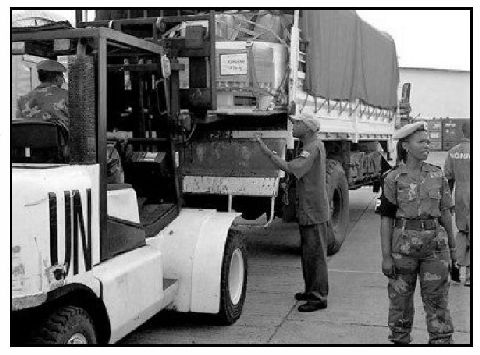
Members of the Air Cargo Handling Team
load cargo onto a truck.
Peace Support Operations
OPERATION MISTRAL involved participation in the United Nations Organisation (UNO) Mission to the Democratic Republic of the Congo (MONUC) from September 1999 to June 2011 and in the UNO’s Stability Mission in the Democratic Republic of Congo from July 2011 to date.
South African National Defence Force participation in this operation commenced on 7 September 1999 with the deployment of one of its newly qualified Military Observers to Kampala, capital of Uganda, as the Capital Liaison Officer for MONUC. This was followed by the deployment of the SANDF Specialist Contingent during April to May 2001. The contingent comprised eight cargo handling teams, airfield crash rescue and fire-fighting teams, an aeromedical evacuation team, and a small headquarters. In April 2002 a Military Police contingent of 48 members was deployed as part of the MONUC Military Police Unit.
During May to June 2003, the SANDF Task Force One, a Task Force Headquarters, an Infantry Battalion Group, Engineer Company, Well Drilling Unit, Ferry Unit and a Headquarters Support Unit deployed and assumed responsibility for Sector 5 of MONUC with Headquarters in Kindu. The Task Force Commander, Colonel Lawrence Smith, was appointed as Sector Commander.
With the establishment of the Kivu Brigade as part of the restructuring of MONUC’s operations in 2004, Task Force One was reorganised with the Commander Task Force One now being appointed as the Chief of Staff of the Kivu Brigade.
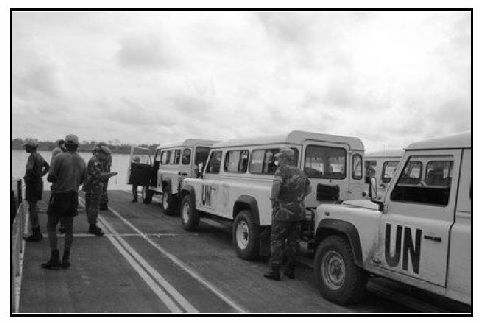
South African Engineers operated a ferry service
across the Congo River at Kindu.
In February 2005 the Eastern Division was established and assumed responsibility for the Kivu Brigades. The Infantry Battalion Group redeployed to Beni as the Divisional Reserve while the Task Force Headquarters and Headquarters Support Unit were withdrawn during the April 2005 rotation. At the same time, Brigadier General Mdutyana became the Deputy Eastern Division Commander.
On request of the United Nations (UN), the South African Air Force (SAAF) Aviation Unit deployed with the UN Operation in Burundi (ONUB), redeployed to MONUC during July 2006. The two Oryx helicopters were deployed at Kamina. During November 2006, the Well Drilling and Ferry Units were withdrawn.
With the security situation deteriorating in Kamina, a protection element was requested. During May 2008 a small contingent from the Maritime Reaction Squadron of the South African Navy (SAN) arrived. This was followed by the deployment of fifteen additional members of the Military Police during the May 2010 rotation. On 30 June 2010, MONUC was terminated. It was replaced by MONUSCO on 1 July 2010.
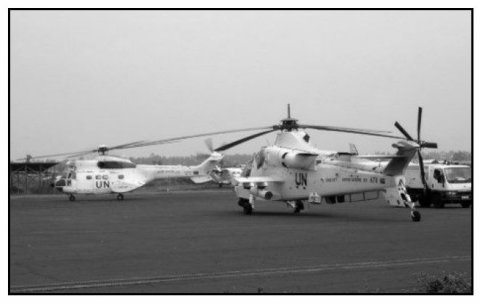
South African Air Force helicopters
deployed in support of MONUSCO.
During March 2013 the concept of operations was amended with the establishment of Force Intervention Brigade. The Aviation Unit was redeployed, and the number of helicopters increased; an additional two Oryx (total of five) helicopters and three Combat Support were deployed. The composition of the Infantry Battalion was amended in the June 2013 rotation. South Africa was also given the Deputy Brigade Commander post and several Military Observers and Staff Officers deployed during Operation MISTRAL.
OPERATION ESPRESSO
From November 2000 to August 2008, South Africa participated in the Organisation of African Unity (OAU, later the African Union, AU) Liaison Mission in Eritrea and Ethiopia (OLMEE) and the United Nations Mission in Eritrea and Ethiopia (UNMEE). Military Observers and Military Staff Officers were deployed in both missions.
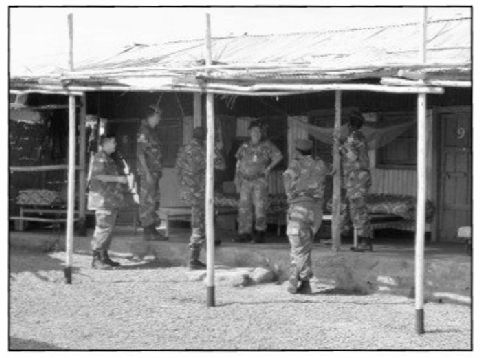
A typical UNMEE Military Observer Team site in a
Temporary Security Zone between Eritrea and Ethiopia.
The initial involvement included the deployment of a Capital Liaison Officer in Addis Abba for OLMEE. This was followed with the deployment of Brigadier General Kamteni as the Senior Military Representative for OLMEE based in Asmara in April 2002. General Kamteni completed his tour of duty in August 2004. In 2002 Captain Adri Fourie became the first South African female Military Observer to deploy when she deployed to UNMEE. UNMEE was terminated on 31 July 2008 and the last South African Military Observers and Staff Officers returned at the end of August 2008. With no further commitments to OLMEE, Operation ESPRESSO closed on 31 August 2008.
OPERATION FIBRE
This operation included SANDF participation in an initial bi-lateral deployment in Burundi from October 2001 to April 2003, in the African Union Mission in Burundi (ONUB) from May 2003 to May 2004, and in the United Nations Operation in Burundi (ONUB) from June 2004 to December 2006.
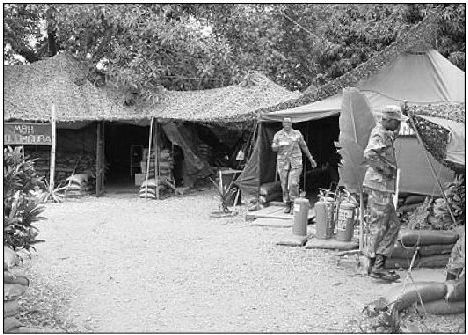
The South African Military Health Service facility
at Palace Base, Bujumbura, Burundi.
The initial deployment was in accordance with the Arusha Peace Agreement and had to be in place by 1 November 2001. Its focus was on the protection of returning leaders to participate in the Burundi Transitional Government. Elements from the South African Army, South African Air Force and the South African Military Health Service deployed. South Africa complied with a strict timeline to conduct the biggest airlift in the history of South Africa.
With the signing of new ceasefire agreements between the various parties, it provided a new moment for the peace process in Burundi. The African Union (AU) established its first Peacekeeping Mission, ONUB, on 1 May 2003, with the South African, Major General Binda, as the first Force Commander. In July 2003 three Harbour Patrol Boats from the South African Navy were deployed for operations on Lake Tanganyika. This meant that all four Services of the SANDF were now deployed.
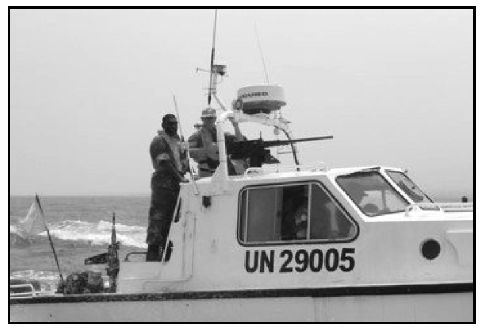
A South African Navy Harbour Patrol Boat in United Nations livery
on patrol on Lake Tanganyika as part of ONUB.
Continued success with the peace process resulted in the United Nations Security Council (UNSC) adopting a resolution authorising the deployment of the ONUB on 1 June 2004. Major General Mgwebi, from South Africa, was appointed as the first Force Commander, the first time that a South African commanded an International Peacekeeping Operation. This required some adjustments to the South African contingent with increases in the Aviation and Maritime elements.
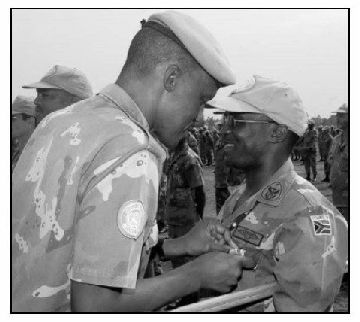
ONUB Force Commander,
Maj Gen Mgwebi, presents
the ONUB medal to a member.
Following the first democratic elections held in Burundi in 2005, ONUB forces were reduced with the South African Aviation Unit withdrawing in April 2006 and the Maritime Unit in October 2006. On 31 December 2006 ONUB was terminated. OPERATION AMPHIBIAN saw South Africa provide assistance to the Third-Party Verification Mechanism (TPVM) in the Democratic Republic of Congo from August 2002 to June 2004. Following the signing of the Pretoria Peace Agreement, in accordance with which all foreign forces had to withdraw from the DRC, the TPVM was established to monitor the withdrawal. The TPVM comprised four members from South Africa and two from the United Nations. Major General Ntshinga led the TPVM. Operation AMPHIBIAN was terminated in June 2004 and all South Africans returned home.
OPERATION SUNRAY
This involved assistance to the European Union Interim Emergency Multinational Force (IEMF) in the DRC from June to September 2003. Following the deteriorating situation in the Ituri Province of the DRC, the UNSC authorised the temporary deployment of the IEMF. As the lead nation of the IEMF, France requested the deployment of an Aviation Unit of 22 personnel and two Oryx helicopters to be used for the transport of cargo and personnel, medical evacuation, casualty evacuation and combat search and rescue. Deployment of the IEMF was terminated in September 2003.
OPERATION MONTEGO involved the deployment of three South African staff officers to the United Nations Mission in Liberia (UNMIL) from October 2003 to January 2005. Early in 2004, South Africa also received an informal request from the United Nations for the deployment of a ship, capable of operating helicopters and boats off the coast of Liberia in support of UNMIL. Unfortunately, South Africa could not comply with the request.
OPERATION CORDITE
This involved the participation in the African Union’s Mission in Sudan (AMIS) from July 2004 to December 2007, the United Nations’ Mission in Sudan (UNMIS) from September 2006 to December 2007, and the United Nations African Union Hybrid Mission in Darfur (UNAMID) from January 2008 to April 2016. The initial deployment involved sending Military Observers and Staff Officers to AMIS, which was followed by the deployment of Infantry and Engineer elements. Staff Officers were deployed in support of UNMIS.
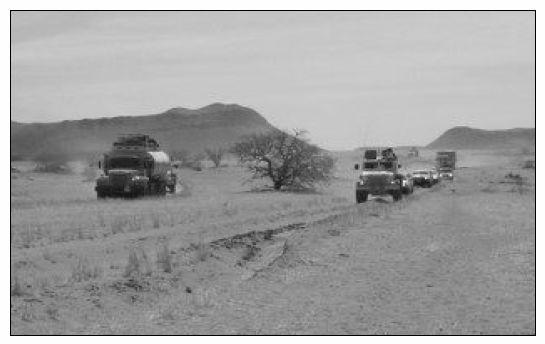
A convoy escort by members of the SANDF is deployed
in support of UNAMID (Photo:UN)
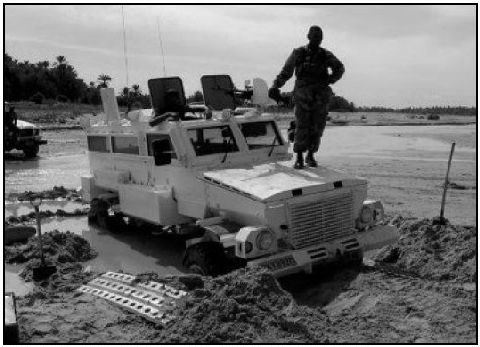
Flash floods caused havoc for
some vehicle patrols during UNAMID.
With the establishment of UNAMID, the South African contingent was increased. During this time, elements from the units destined for deployment to Darfur received training in desert warfare in Tunisia. South Africa’s Major General Mudutyana was appointed as Deputy Force Commander of UNAMID and completed his tour of duty in November 2010. The South African forces withdrew from UNAMID during April 2016, but some Staff Officers and Military Observers remained in the mission under Operation MBUMBA.
OPERATION PRISTINE was participation in the bilateral agreement in support of the peace process in Côte d'Ivoire from July 2005 to December 2006. Following the signing of the Pretoria Peace Agreement on 6 April 2005, members of the SANDF deployed as monitors to various Disarming, Demobilisation and Reintegration (DDR) sites. The operation was terminated in December 2006, and the members of the SANDF returned to South Africa.
OPERATION CURRICULUM
This operation assisted the African Union Special Task Force (AUSTF) in Burundi from January 2007 to November 2009. Continued mediation between the elected Government of Burundi and the Palipehutu – FNL resulted in the signing of a peace agreement on 7 September 2006. As ONUB was due to close on 31 December 2006, South Africa was requested to retain troops in Burundi from 1 January 2007 to protect the Palipehutu – FNL combatants on their way to the integration sites. The SANDF elements withdrew during November 2009.
In OPERATION INDULI, Military Observers were deployed in support of the United Nations Mission in Nepal from April 2007 to July 2009. This was a deployment outside the African Continent and the members were required to deploy in civilian attire. Each member received a special allowance from the United Nations to procure civilian attire for the deployment. Operation INDULI was terminated on 31 July 2009.
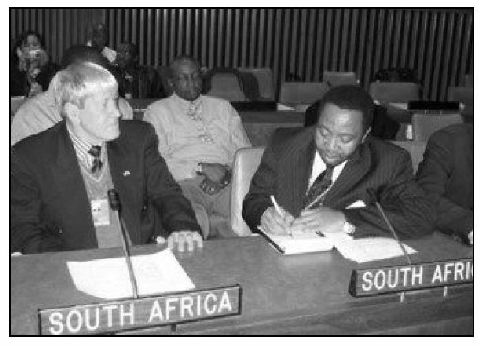
South African National Defence Force representatives
at the 2008 Triennial Review of the COE Manual
at United Nations Headquarters.
OPERATION BONGANE
This operation provided assistance to the peace process between the Government of Uganda and the Lord's Resistance Army (LRA) in Northern Uganda and Southern Sudan over the period June 2007 to July 2009.
Two Military Observers were deployed and the operation was terminated on 31 July 2009.
OPERATION VIGILANCE
Under this operation, support was provided to the United Nations Supervision Mission in Syria (UNSMIS) from June to July 2012. Here the initial UNSC resolution required the deployment of 300 military observers in support of UNSMIS. Due to the urgency of the mission, it was decided to transfer military observers from existing missions. South Africa was requested to transfer two military observers from MONUSCO to UNSMIS and to consider the further deployment of an additional six. Due to the deteriorating security situation in Syria, the deployment of the additional six military observers was placed on hold, and the two initially deployed returned to MONUSCO on 2 July 2012.
Other Peace Mission activities
COE MANUAL REVISIONS
In 2001 the SANDF was first represented at the triannual review of the United Nations Policy and Procedure for Reimbursement of Contingent Owned Equipment (commonly referred to as the COE Manual). Since then members regularly attended, and in 2008 a member of the SANDF was elected as co-chairman of the Self Sustainment Sub Working Group.
MEMORANDA OF UNDERSTANDING
A small team of the Department of Defence travelled to the United Nations Headquarters in New York during April 2001 to negotiate the first Memorandum of Understanding (MOU) between the United Nations and the Government of the Republic of South Africa. Since then, a team from the department has annually visited the United Nations Headquarters to discuss the various MOU.
UNITED NATIONS DOCTRINE DEVELOPMENT WORKSHOP
During January 2007 three members of the SANDF attended the United Nations Doctrine Development Workshop in Carlisle, Pennsylvania, United States. The workshop was jointly organised by the United Nations Department of Peacekeeping Operations and the United States of America Army Peacekeeping and Stability Operations Institute.
PEACE MISSION TRAINING CENTRE
Following the opening of the Peace Mission Training Centre in November 2007, the SANDF commenced with the presentation of Peacekeeping courses at the centre in 2008. Nine peacekeeping- related courses were presented to some 400 students. Several foreign lecturers were invited to participate in the various courses.
UNITED NATIONS SPECIAL COMMITTEE ON PEACE SUPPORT OPERATIONS – C34
Since 2012, members of the SANDF regularly attended the meetings of the United Nations Special Committee on Peace Support Operations, known as the C34.
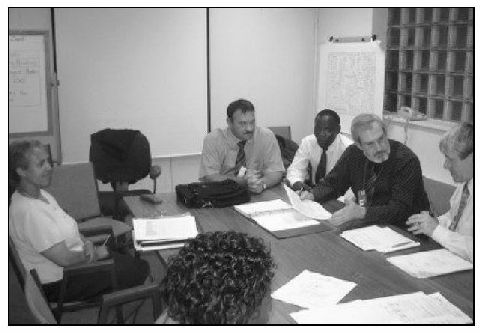
Members of the Department of Defence team
in discussions with members of the United Nations
Department of Peacekeeping Operations during a
Memorandum of Understanding meeting.
Return to Journal Index OR Society's Home page
South African Military History Society / scribe@samilitaryhistory.org